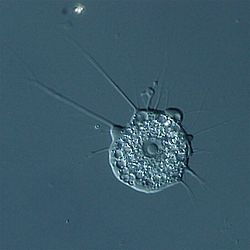ホロマイコータ
表示
| ホロマイコータ | ||||||||||||
|---|---|---|---|---|---|---|---|---|---|---|---|---|
 Nuclearia
| ||||||||||||
| 分類 | ||||||||||||
| ||||||||||||
| 学名 | ||||||||||||
| Holomycota Liu et al., 2009[1] | ||||||||||||
| シノニム | ||||||||||||
| ||||||||||||
| 下位分類群 | ||||||||||||
|
(本文参照) |
ホロマイコータ(Holomycota)またはNucletmycea[注釈 1]は、真菌とそれに近縁な原生生物を含むクレードである。オピストコンタに属し、後生動物とそれに近縁な原生生物を含むホロゾアとは対をなす。
系統
[編集]おおよそ以下のような系統関係が示されている[4][5][6]。
| オピストコンタ |
| |||||||||||||||||||||||||||||||||||||||
| Opisthokonta |
注釈
[編集]参考文献
[編集]- ^ Liu et al. (2009). “Phylogenomic analyses predict sistergroup relationship of nucleariids and Fungi and paraphyly of zygomycetes with significant support”. BMC Evol. Biol. 9 (1): 272. doi:10.1186/1471-2148-9-272.
- ^ Brown et al. (2009). “Phylogeny of the "forgotten" cellular slime mold, Fonticula alba, reveals a key evolutionary branch within Opisthokonta”. Mol. Biol. Evol. 26 (12): 2699–2709. doi:10.1093/molbev/msp185.
- ^ Adl et al. (2019). “Revisions to the Classification, Nomenclature, and Diversity of Eukaryotes”. J. Eukaryot. Microbiol. 66: 4-119. doi:10.1111/jeu.12691.
- ^ a b Torruella et al. (2018). “Global transcriptome analysis of the aphelid Paraphelidium tribonemae supports the phagotrophic origin of fungi”. Comm. Biol. 1 (1): 231. doi:10.1038/s42003-018-0235-z.
- ^ Hibbett et al. (2018). “Phylogenetic taxon definitions for Fungi, Dikarya, Ascomycota and Basidiomycota”. IMA Fungus 9 (2): 291-298. doi:10.5598/imafungus.2018.09.02.05.
- ^ Tedersoo et al. (2018). “High-level classification of the Fungi and a tool for evolutionary ecological analyses”. Fungal Diversity 90 (1): 135-159. doi:10.1007/s13225-018-0401-0.
- ^ Hibbett et al. (2018). “Phylogenetic taxon definitions for Fungi, Dikarya, Ascomycota and Basidiomycota”. IMA Fungus 9: 291-298. doi:10.5598/imafungus.2018.09.02.05.
